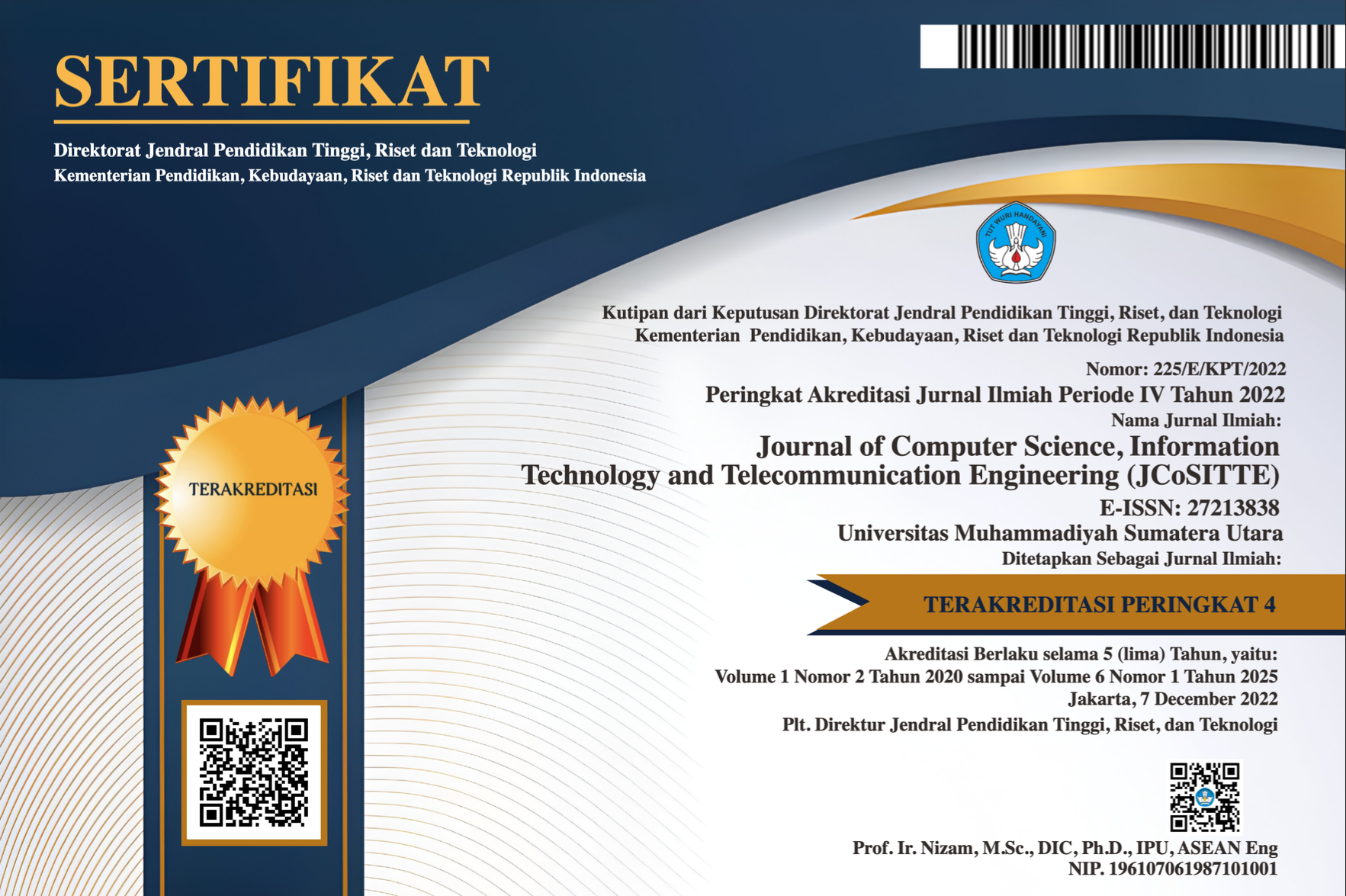Implementation of Marker Based Tracking Method in the Interactive Media of Traditional Clothes Knowledge-Based on Augmented Reality 360
Abstract
Keywords
Full Text:
PDFReferences
Abdulghani, T., & Sati, B. P. (2020). Pengenalan Rumah Adat Indonesia Menggunakan Teknologi Augmented Reality Dengan Metode Marker Based Tracking Sebagai Media Pembelajaran. Media Jurnal Informatika, 11(1), 43-50.
ADLINA, F. (2020). Strategi Komunikasi Humas Museum Lampung Dalam Mempromosikan Koleksi Budaya Adat Lampung Kepada Masyarakat Kota Bandar Lampung.
Al-Khowarizmi, A. K., Fauzi, F., Sari, I. P., & Sembiring, A. P. (2020). The Effect of Indonesian and Hokkien Mobile Learning Application Models. Journal of Computer Science, Information Technology and Telecommunication Engineering, 1(1), 1-7.
Al-Khowarizmi, A. K., Nasution, I. R., Lubis, M., & Lubis, A. R. (2020). The effect of a SECoS in crude palm oil forecasting to improve business intelligence. Bulletin of Electrical Engineering and Informatics, 9(4).
Al-Khowarizmi, Sitompul, O. S., Suherman, & Nababan, E. B. (2017, December). Measuring the Accuracy of Simple Evolving Connectionist System with Varying Distance Formulas. In Journal of Physics: Conference Series (Vol. 930, No. 1, p. 012004). IOP Publishing.
Campbell, B. A., & Baars, C. (Eds.). (2019). The Curation and Care of Museum Collections. Routledge.
Cheng, K. H., & Tsai, C. C. (2013). Affordances of augmented reality in science learning: Suggestions for future research. Journal of science education and technology, 22(4), 449-462.
Grubert, J., & Grasset, R. (2013). Augmented reality for Android application development. Packt Publishing Ltd.
Haryani, P., & Triyono, J. (2017). Augmented Reality (Ar) Sebagai Teknologi Interaktif Dalam Pengenalan Benda Cagar Budaya Kepada Masyarakat. Simetris : Jurnal Teknik Mesin, Elektro Dan Ilmu Komputer, 8(2), 807. doi:10.24176/simet.v8i2.1614
Haryani, P., & Triyono, J. (2017). Augmented Reality (Ar) Sebagai Teknologi Interaktif Dalam Pengenalan Benda Cagar Budaya Kepada Masyarakat. Simetris: Jurnal Teknik Mesin, Elektro Dan Ilmu Komputer, 8(2), 807-812.
Herawati, F. A., & Prihandono, B. K. (2018). Peran Jejaring Sosial dalam Pembangunan Komunitas Kreatif. E-PROCEEDING COMICOS 2018, 184.
Kamelia, L. (2015). Perkembangan Teknologi Augmented Reality Sebagai Media Pembelajaran Interaktif Pada Mata Kuliah Kimia Dasar. Jurnal Istek, 9(1).
Liong, B. C. (2019). Perancangan Augmented Reality (AR) berbasis Android Sebagai Media Pembelajaran Pakaian Adat Tradisional di Indonesia untuk Anak Sekolah Dasar (Doctoral dissertation, Universitas Internasional Batam).
Listyorini, T. (2014). 3d-Catalog Mountain View Resident Berbasis Augmented Reality. Prosiding SAINTIKS.
Lubis, A. R., Lubis, M., Al-Khowarizmi, & Listriani, D. (2019, August). Big Data Forecasting Applied Nearest Neighbor Method. In 2019 International Conference on Sustainable Engineering and Creative Computing (ICSECC) (pp. 116-120). IEEE.
Lubis, A. R., Lubis, M., Al-Khowarizmi. (2020). Optimization of distance formula in K-Nearest Neighbor method. Bulletin of Electrical Engineering and Informatics, 9(1), 326-338.
Mahmudah, S. N. (2019). Pemanfaatan Monumen Perjuangan 45 Limbangan Kendal Sebagai Sumber Belajar Sejarah Pada Siswa Kelas Xi Ips Sma Negeri 1 Limbangan Kendal Tahun Pelajaran 2018/2019 (Doctoral dissertation, UNNES).
Mahon, B. Z., & Caramazza, A. (2008). A critical look at the embodied cognition hypothesis and a new proposal for grounding conceptual content. Journal of physiology-Paris, 102(1-3), 59-70.
Mustaqim, I. (2017). Pengembangan Media Pembelajaran Berbasis Augmented Reality. Jurnal Edukasi Elektro, 1(1).
Nurdyansyah, N., & Fahyuni, E. F. (2016). Inovasi Model Pembelajaran Sesuai Kurikulum 2013.
Prabowo, R., Listyorini, T., & Susanto, A. (2015). Pengenalan Rumah Adat Indonesia Berbasis Augmented Reality dengan Memanfaatkan KTP sebagai Marker. Prosiding SNATIF, 51-58.
Prayudani, S., Hizriadi, A., Lase, Y. Y., Fatmi, Y., Al-Khowarizmi. (2019, November). Analysis Accuracy Of Forecasting Measurement Technique On Random K-Nearest Neighbor (RKNN) Using MAPE And MSE. In Journal of Physics: Conference Series(Vol. 1361, No. 1, p. 012089). IOP Publishing.
Putra, E. Y., Wahyudi, A., & Tumilaar, A. (2018). Virtual Reality 360 Interaktif Wisata Digital Kota Tomohon dengan Tampilan Stereoscopic. CogITo Smart Journal, 4(1), 104-112.
Sahulata, R. A., Wahyudi, A., Wuwungan, B. G., & Nayoan, M. A. (2016). Aplikasi Virtual Reality Pengenalan Kerangka Tubuh Manusia Berbasis Android. CogITo Smart Journal, 2(2), 204-215.
Setyawan, R. A., & Dzikri, A. (2016). Analisis penggunaan metode marker tracking pada augmented reality alat musik tradisional jawa tengah. Simetris: Jurnal Teknik Mesin, Elektro dan Ilmu Komputer, 7(1), 295-304.
Star, S. L., & Griesemer, J. R. (1989). Institutional ecology, translations' and boundary objects: Amateurs and professionals in Berkeley's Museum of Vertebrate Zoology, 1907-39. Social studies of science, 19(3), 387-420.
DOI: https://doi.org/10.30596/jcositte.v1i2.4501
Refbacks
- There are currently no refbacks.





.png)

